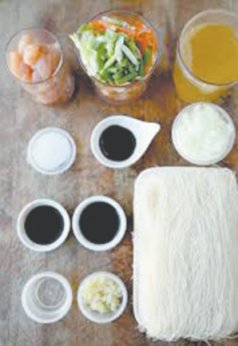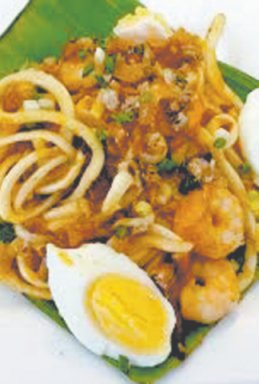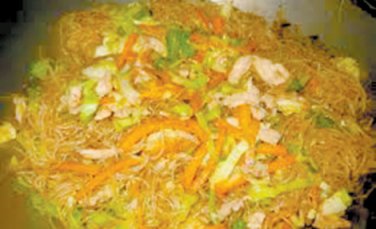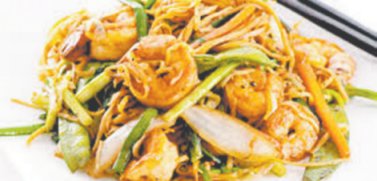
By: Aeron Lancero
Magandang araw sa inyo lahat, and hope you are enjoying the many April Showers that will bring us some amazing May flowers. This weather in April is just interesting but the nice weather is coming close and when that happens we Filams love to start partying a bit more. That said, I am sharing a little history on a dish that is always on our tables.
This is a dish that has large significance as it’s a dish that represents long life, long relationships, and long prosperity. That dish is PANCIT!!! And we have many versions of it.
Below is a little history, an array of different kinds, a simple recipe you can use at home and a few places I would recommend for some great pancit.
NEXT TO rice, pancit is the perennial item on the Filipino dining table. Even to a Westerner, Filipino cuisine means: 1. adobo; 2. lumpiang shanghai; and 3. pancit luglog. Such is the impact of pancit in our culinary profile.
The convenience and simplicity of this starchy food is the key to its popularity in this country — more so now, with the younger set hooked on noodles in all shapes and forms.
Pancit, borrowed from the Chinese, then innovated and adopted into our cuisine, connects us to our Asian roots. But more importantly, it is a veritable Pinoy comfort food — easier to cook than rice, and more versatile and food combination-friendly. It is the faster fast food. In fact, “pancit” is derived from the Hokkien “pian i sit,” which means “something conveniently cooked fast.”
The first pancit that landed in the Philippines is likely to have been made from wheat noodles brought as baon by a Chinese trader. Sometime later, another Chinese merchant probably tried his hand on making his own noodles when his baon ran out. With usisero (inquisitive) natives by his side, he may have experimented with batch-after-batch until he produced something that looked like what he may have had in his homeland. But since rice, not wheat, was on hand, he made rice noodles. Rice starch differs in nature from wheat, having less gluten that provides that familiar “bite.” Rice noodles are whiter in color and have less “muscle” in body. But that may not have mattered much to the homesick Chinese trader; pancit was pancit, and anyway rice noodles could be had in China as well.
The Chinese also taught us that if you wish to go through many decades, then you should eat birthday noodles instead of cake. Noodles represent long life and good health; they must not be cut short so as not to corrupt the symbolism. In lieu of candles, the stir-fried miswa noodles or thin canton noodles would be topped with red- or orange-tinted quail eggs; sweet, golden, fried shallot slivers; and green onion leaves.
Even “everyday” noodles are eaten with that hidden desire to have a healthy life. But that will hardly happen if you eat “yagit pancit,” or a starch-on-starch combination that will also make you lose the fight against weight gain. Yagit pancit is pancit stuffed in pan de sal, pancit sandwiched between slices of white bread, pancit and rice. Yes, we are talkingpancit ulam. No long-life noodles here—there are not enough nutrients in noodles to subsist on them alone or combined with more starch.
But here we are with a younger generation gone gaga over instant noodles, which have invaded every grocery, convenience store, and call centers in the country. In some ways, it really is the ultimate convenience food. Even if one does not have hot water to cook it, the crispy noodles can become a snack by themselves. Time for a confession: I have indulged in this convenience myself, when faced with serious deadlines, eating the uncooked noodles as if they were shing-aling without the spice. Instant noodles are pre-cooked, after all, deep-fried into their crispy incarnation before being packed. I remember reading somewhere that high-temperature frying of noodles somehow turned it carcinogenic, but since that hasn’t been fully explained to me yet, any fear I may have of a deadly noodle remains on hold.
Still, there is nothing like the real thing — and we have so many of it, too! Because the Chinese merchant’s rice noodles or bihon are easily breakable, a variety with egg was added down the line. Rice noodles with eggs are usually considered as — surprise! — “egg noodles.” If mongo-bean starch is used, sotanghon (glass noodles or vermicelli) is produced.
Credit soy sauce for ensuring the presence of pancit in Philippine home cooking. Soy sauce or toyo’s nutty, delicate flavor complements the linear taste of rice noodles. Sautéed in toyo and broth, the bihon also turns golden brown, making it look all the more appetizing and “saraaaap (delicious)” by Pinoy standards.
Pancit Bihon: There’s also the hodge-podge of chopped ingredients, sautéed with the seasonings, that give a pancit dish more layers of taste: finely sliced veggies (like onions, cabbage, green beans, young corn, bell pepper, etc.); finely sliced meats (pork, chicken breast, chicken giblets, pork liver, etc.) and seafood and greens (fresh shrimp, oysters, squid, with wansoy or cilantro, kinchay or Chinese celery, onion leaves, and much more.)
All these rich ingredients beef up a pancit and give it its distinct character. The more toppings, the better. The more costly the toppings, the better. The toppings are also clues to a pancit’s “hometown,” which will certainly have its trademark produce — oysters and shrimps for a coastal town, for example, and pork crackling for hog-growing areas — dressing up the noodles.
But while there are many kinds of pancit, it comes in only two forms: dry or with soup. Pancit guisado falls under the dry form, although broth is involved in making it. Aside from broth, rice starch, soy sauce, and then the toppings or sahog complete the pancit guisado recipe. The broth for sautéing the noodles in can be either soy sauceginger based or shrimp liqueurbased. But sometimes, the bored cook combines these concoctions.
Another kind of “dry” pancit comes with sauce, like pancit Malabon. Pancit Malabon Pancit Canton Noodles with soup include pancit mami, pancit molo, and the Ilonggo’s pride, batchoy. Usually the broth is chicken-based.
The hearty noodle soup often comes with sahog like slices of chicken or beef, a sprinkling of chopped spring onions and chicharon, and bits of toasted garlic.
But there is still so much that can be done with pancit. How about a super-fiber pancit made with rice bran or darak? Or gata (coconut) sauce for pancit instead of using heavy cream? Anyone for pancit sampler plates or an all-pancit buffet?
There is, though, one more kind of pancit: it comes in a brown bag borne home by husband for the wife each time he reaches the bedroom behind schedule for reasons less than saintly. It is a miracle pancit and has saved lives, sustained domestic peace, and kept the noise down. It’s a wonder no one has made millions yet out of Peace Pancit!
The Peace Pancit is a true story…. For the younger generation you should ask your father…Here is a recipe that is easy to follow:
Pancit Bihon
By Measure
1/2 pound rice vermicelli noodles (Soak noodles in HOT tap water for 10 minutes before using.Drain well)
Ingredients
1 teaspoon garlic
1 teaspoon ginger
2 tablespoons vegetable oil
1/4 cup yellow onion sliced
1/4 cup shredded carrots
2 chicken breasts, julienned
2 tablespoons soy
2.5 cups chicken stock
1/4 cup celery, diced
1 cup savoy cabbage, julienned
4 green onions, sliced
1/4 cup sliced Chinese sausage
Fish Sauce to taste or optional (Patis) Recommend 1 1/2 teaspoon for the beginner
1 1/2 lemon, juiced
Preparation
1. Begin by heating your wok or large skillet to medium-high heat. Add the vegetable oil to the wok. When the oil is hot, start with the onion, garlic and ginger. Cook for 30 seconds stirring often. Next, add the Chinese sausage. Cook for 3 minutes stirring occasionally. Add the chicken and cook until the chicken is done. This will give us a nice base of flavor.
2. Still at medium-high heat, add the carrots to the mixture. Cook for 2 minutes then add the chicken stock and soy sauce. Bring the chicken stock mixture to a boil. When you reach a boil, add the rice noodles. The trick here is to fold the noodles into the stock. Let the noodles soften on one side then gently toss and turn the noodles into the mixture. Continue cooking at a simmer until the noodles are done and have absorbed the stock. (Depending on your boil, you may require more chicken stock.) Remove the wok from the heat. Add the celery and mix.
3. We have a flavorful dish, now lets make it better. Here is how we finish this dish. What makes this dish is Filipino fish sauce (patis) and the lemon. Sprinkle the dish with the fish sauce and lemon juice to taste. Toss gently. Taste the dish then adjust with salt and pepper. I hope you enjoyed. Live long and prosper my kababayans…

Pancit Recipe

Pancit Malabon

Pancit Bihon

Pancit Canton
 VIA Times – April 2016 Issue Vital News, Vibrant Views for Asian Americans in Chicago & Midwest
VIA Times – April 2016 Issue Vital News, Vibrant Views for Asian Americans in Chicago & Midwest

